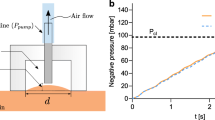Abstract
An experimental method for obtaining the 2-dimensional skin tension/extension-ratio characteristics of living human skin is described. This method incorporates a strain-gauged pretension device used to determine the naturally existing tension and deformation fields in a specific skin area and a suction-cup system that applies a homogeneous, plane strain field to the skin at controlled straining rates. A series of experiments conducted to validate the use of the method for obtaining quantitative measures of the mechanical behaviour of skinin vivo is also presented. This method is being used to investigate the variation of mechanical properties with such factors as age, sex, hormonal change, ultraviolet radiation and various disease states.
Sommaire
Une méthode expérimentale de détermination de la tension de la peau en deux dimensions par rapport au coefficient d'extention de la peau d'individus vivants est décrite. Cette méthode utilise un dispositif de prétensionnement à jauge de contrainte utilisé pour déterminer les champs de tension et de déformation normalement existant sur une surface de peau donnée. Un dispositif à ventouse applique un champ de déformation plan et homogène à la peau selon des valeurs contrôlées. Une série d'expériences effectuée pour démontrer le bien-fonde decette méthode pour la mesure quantitative du comportement mécanique de la peauin vivo est également présentée. Cette méthode est utilisée actuellement pour déterminer les variations de ces propriétés mécaniques en fonction de facteurs tels que l'âge, le sexe, les modifications hormonales, les ultraviolets et à la suite de diverses affections.
Zusammenfassung
Eine Methode zur Bestimmung der Merkmale des Verhältnisses von zweidimensionaler Hautspannung zur-ausdehnung bei lebender menschlicher Haut wird beschrieben. Diese Methode bedient sich einer auf Anspannung geeichten Vorspannungsvorrichtung, die dazu verwendent wird, die natürlich bestehenden Spannungs- und Verformungsfelder in einer bestimmten Hautregion zu bestimmen, sowie eines Saugschalensystems, das ein homogenes Feld ebener Deformation in gesteuerten Anspannungsraten an die Haut anlegt. Außerdem wird eine Reihe von Experimenten beschrieben, die durchgeführt wurden, um die Eignung der Methode für quantitative Messungen des mechanischen Verhaltens von Haut am lebenden Organismus zu prüfen. Diese Methode wird dazu verwendet, Variationen der mechanischen Eigenschaften unter Einwirkung von Faktoren wie Alter, Geschlecht, Hormonänderungen, Ultravioletteinstrahlung und verschiedener Krankheitsheitszustände zu untersuchen.
Similar content being viewed by others
References
Alexander, H. andCook, T. (1975) Variations with age in the mechanical properties of human skin.Biomechanics of tissue viability and clinical applications (Kenedi, R. M. ed.), MacMillan, 109–117.
Alexander, H. andCook, T. (1976) Accounting for natural tension in the mechanical testing of human skin. Methods of measurement of the physical properties of human skin.J. Invest. Dermatol.
Alexander, H. andCook, T. (1976) A constitutive relation for mechanically characterizing human skin. Digest of the 11th international conference on medical and biological engineering.
Alexander, H. (1967) Deformation and stress analysis of balloons. Ph.D. thesis, New York University.
Barbanel, J. C., Evans, J. H. andFinlay, J. B. (1973) Stress-strain-time relations for soft connective tissues.Perspectives in bioengineering (Kenedi, R. M. ed.). University Park Press, 165.
Chu, B. M. andBrody, G. (1975) Nondestructive measurements of the properties of healing burn scars.Med. Instrum.,9, 139.
Cook, T. andAlexander, H. (1975) The measurement of natural tension in human skin. 28th ACEMB, 178.
Cook, T. H. (1975) The mechanical characterization of human skinin vivo. Ph.D. thesis, Stevens Institute of Technology.
Evans, J. H. andSiesennop, W. (1967) Controlled quasistatic testing of human skinin vivo. Digest of the 7th International Conference on Medical Biological Engineering, Stockholm, 371.
Finlay, B. (1970) Dynamic mechanical testing of human skinin vivo.J. Biomech. 3, 557.
Grahame, R. (1970) A method for measuring human skin elasticityin vivo with observations on the effects of age, sex and pregnancy.Clin. Sci. 39, 223.
Grahame, R. (1968) Elasticity of human skinin vivo.Ann. Phys. Med. 10, 130.
Lanir, Y. andFung, Y. C. (1974a) Two-dimensional mechanical properties of rabbit skin—I. Experimental system.J. Biomech. 7, 29.
Lanir, Y. andFung, Y. C. (1974b) Two-dimensional mechanical properties of rabbit skin—II. Experimental results.,7, 171.
Millington, P. F., Gibson, T., Evans, J. H. andBarbanel, J. C. (1971) Structural and mechanical aspects of connective tissue.Adv. Biomed. Eng. 1, 189.
Rivlin, R. S. andSaunders, D. W. (1951) Large elastic deformations of isotropic materials—Part VII. Experiments of the deformation of rubber.Proc. R. Soc. A 243, 251.
Thacker, J. G., Iachetta, F. A., Alliare, P. E., Edgerton, M. T., Rodeheaver, G. T. andEdlich, R. R. (1976)Biomechanical properties of skin: Their influence on planning surgical excisions; Basic science in plastic surgery, Mosby.
Vlasblom, D. C. (1967) Skin elasticity, Ph.D. thesis, University of Utrecht, Netherlands.
Wilkes, G. L., Brown, I. A. andWildnauer, R. H. (1973) The biomechanical properties of skin. CRC Critical Reviews in Bioengineering, 453.
Author information
Authors and Affiliations
Rights and permissions
About this article
Cite this article
Cook, T., Alexander, H. & Cohen, M. Experimental method for determining the 2-dimensional mechanical properties of living human skin. Med. Biol. Eng. Comput. 15, 381–390 (1977). https://doi.org/10.1007/BF02457990
Received:
Accepted:
Issue Date:
DOI: https://doi.org/10.1007/BF02457990



